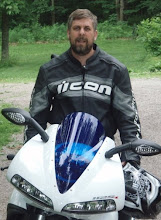Canfield, C. and D. Gess. 2008. 25 Years of Buell. Whitehourse Press, Center Conway, NH.
Being a Buell lover, I couldn't wait to get my hands on this book. Admittedly, I am relatively new to the world of Buell compared to some others. My first ride on an 1125R a couple of years ago made up my mind quickly. So much so, I decided I needed a CR too! What an awesome platform. (I wouldn't turn down a Ulysses if it found its way into my paddock either.) I read with quite some fascination about the trials and tribulations of Erik Buell in getting a fledgling company started. Probably not much unlike what a lot of small businesses go through, but certainly nothing like what the mega-motor companies deal with. It is a story of dedication, passion, and commitment for sure. I loved the notion of the “Buell Values” and “red light policy”...if only more businesses were run that way. At 127 pages the book is disappointingly short and not very deep in content, but was produced well and included excellent photographs. Some interviews with Erik directly, and more of the back story with HD, would have made the book more interesting. Perhaps a stylistic issue, but the book was a bit tough to get through--anything but a linear writing style. There were so many side boxes and story-lets that got in the way of actually “reading” the book. A bit schizophrenic actually. As a Buell lover, I give the book 4-stars (out of 5); but realistically, given its style and content, it is probably a 3-star book for the rest of the MC world.
Trevitt, A. 2008. Sportbike Suspension Tuning. David Bull Publishing, Phoenix, AZ.Oddly, most of the people I run in to spend bucket loads of time, money, and energy in trying to increase the performance of their sportbikes. Many don't make it past the end of the first week without a major modification. While I am not entirely immune from this myself, I've never fully understood this philosophy, other than it just seems like a very “American” thing to do. Europeans, for example, do comparatively little in the way of bike alteration and performance modification. Most of the major manufacturers put quite some time and effort into engineering these bikes for optimal performance from the get-go, most of which can never be realized on the street anyway. What am I leading up to? There are a load of suspension adjustments that are possible on most of todays' sportbikes, but few invest much time or energy in to understanding the intricacies of suspension tuning (not to mention its free). I suppose a lot of folks chalk it up as “too complicated”. Indeed, there are a number of things to keep track of, but it is fairly simple physics (most of which can be delivered with a flat-blade screwdriver). More importantly, these settings can have a dramatic effect on handling. Trevitt does a nice job in explaining the basic principles and theory behind suspension tuning and covers all the basics (well illustrated via clear photography by the way) like pre-load, sag, damping, and squat adjustments as well as tire and fork issues. At 128 pages, the book is relatively short, but the topic is narrow, and the book is packed with information. A good balance actually. I rate it 4.5 stars.
Everitt, C. 2007. How to Repair Your Motorcycle. MBI Publishing, Minneapolis, MN. I guess I have always like wrenching to some degree. There is a satisfaction that comes from working on your own bike that adds an additional dimension to the experience. I do end up at a dealer when I think something is warrantable and/or I have just flat run out time to do something myself. On occasion, I have gotten myself over my head with a major project. But, for the most part, motorcycle maintenance is not rocket science and quite enjoyable (if you like working with your hands and have an adequate collection of tools).
How to Repair Your Motorcycle is one of many maintenance books that have appeared in recent years. It is well written, well illustrated, and pretty straightforward. Most of the projects described (fluids, filters, lubrication, adjustments, etc.) cover all the basic aspects of annual or periodic maintenance. Major projects or modifications are not discussed so I suspect that this book is largely targeted towards the beginner to intermediate wrencher. But we all need to start somewhere. In combination with the owners manual and repair manual for your specific bike, I suspect that 80-90% of most routine maintenance projects can be tackled with this book. I rate it 4-stars.









